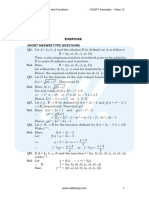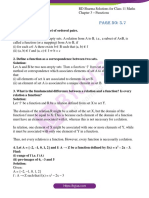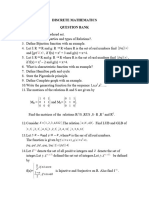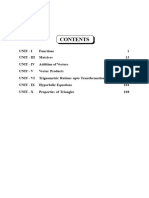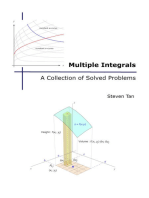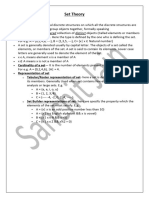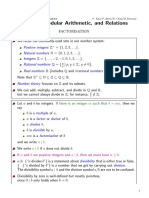Maths Notes Xii Relations and Functions Board Exam Imp Qa
Maths Notes Xii Relations and Functions Board Exam Imp Qa
Uploaded by
Jyotsnarani KhatuaCopyright:
Available Formats
Maths Notes Xii Relations and Functions Board Exam Imp Qa
Maths Notes Xii Relations and Functions Board Exam Imp Qa
Uploaded by
Jyotsnarani KhatuaOriginal Description:
Copyright
Available Formats
Share this document
Did you find this document useful?
Is this content inappropriate?
Copyright:
Available Formats
Maths Notes Xii Relations and Functions Board Exam Imp Qa
Maths Notes Xii Relations and Functions Board Exam Imp Qa
Uploaded by
Jyotsnarani KhatuaCopyright:
Available Formats
CHAPTER – 1: RELATIONS AND FUNCTIONS
MARKS WEIGHTAGE – 06 marks
Previous Years Board Exam (Important Questions & Answers)
1. If f(x) = x + 7 and g(x) = x – 7, x∈R, find ( fog) (7)
Ans:
Given f(x) = x + 7 and g(x) = x – 7, x∈R
fog(x) = f(g(x)) = g(x) + 7 = (x – 7) + 7 = x
(fog) (7) = 7.
3x 2
2. If f(x) is an invertible function, find the inverse of f (x) =
5
Ans:
3x 2
Given f ( x )
5
3x 2
Let y
5
5y 2
3x 2 5 y x
3
5x 2
f 1 ( x )
3
3. Let T be the set of all triangles in a plane with R as relation in T given by R = {(T1, T2) :T1
T2}. Show that R is an equivalence relation.
Ans:
(i) Reflexive
R is reflexive if T1 R T1
Since T1 T1
R is reflexive.
(ii) Symmetric
R is symmetric if T1 R T2 T2 R T1
Since T1 T2 T2 T1
R is symmetric.
(iii) Transitive
R is transitive if T1 R T2 and T2 R T3 T1 R T3
Since T1 T2 and T2 T3 T1 T3
R is transitive
From (i), (ii) and (iii), we get R is an equivalence relation.
4. If the binary operation * on the set of integers Z, is defined by a *b = a + 3b2 , then find the
value of 2 * 4.
Ans:
Given a *b = a + 3b2 a, b z
2*4 = 2 + 3 x 42 = 2 + 48 = 50
5. Let * be a binary operation on N given by a * b = HCF (a, b) a, b N. Write the value of 22 * 4.
Ans:
Given a * b = HCF (a, b), a, b N
22 * 4 = HCF (22, 4) = 2
Prepared by: M. S. KumarSwamy, TGT(Maths) Page - 1 -
n 1
2 , if n is odd
6. Let f : N N be defined by f (n) for all n N . Find whether the
n , if n is even
2
function f is bijective.
Ans:
n 1
2 , if n is odd
Given that f : N N be defined by f (n) for all n N .
n , if n is even
2
Let x, y N and let they are odd then
x 1 y 1
f ( x) f ( y ) x y
2 2
If x, y N are both even then also
x y
f ( x) f ( y ) x y
2 2
If x, y N are such that x is even and y is odd then
x 1 y
f ( x) and f ( y )
2 2
Thus, x y for f(x) = f(y)
Let x = 6 and y = 5
6 5 1
We get f (6) 3, f (5) 3
2 2
f(x) = f(y) but x y ...(i)
So, f (x) is not one-one.
Hence, f (x) is not bijective.
7. If the binary operation *, defined on Q, is defined as a * b = 2a + b – ab, for all a, b Q, find
the value of 3 * 4 .
Ans:
Given binary operation is a*b = 2a + b – ab
3* 4 = 2 3 + 4 – 3 4
3* 4 = –2
| x 1|
8. What is the range of the function f ( x ) ?
( x 1)
Ans:
| x 1|
We have given f ( x )
( x 1)
( x 1), if x 1 0 or x 1
| x 1|
( x 1), if x 1 0 or x 1
( x 1)
(i) For x > 1, f ( x) 1
( x 1)
( x 1)
(ii) For x < 1, f ( x ) 1
( x 1)
| x 1|
Range of f ( x ) is {–1 , 1}.
( x 1)
Prepared by: M. S. KumarSwamy, TGT(Maths) Page - 2 -
9. Let Z be the set of all integers and R be the relation on Z defined as R = {(a, b) ; a, b Z, and
(a – b) is divisible by 5.} Prove that R is an equivalence relation.
Ans:
We have provided R = {(a, b) : a, b Z, and(a – b) is divisible by 5}
(i) As (a – a) = 0 is divisible by 5.
(a, a) R a R
Hence, R is reflexive.
(ii) Let (a, b) R
(a – b) is divisible by 5.
– (b – a) is divisible by 5.
(b – a) is divisible by 5.
(b, a) R
Hence, R is symmetric.
(iii) Let (a, b) R and (b, c) Z
Then, (a – b) is divisible by 5 and (b – c) is divisible by 5.
(a – b) + (b – c) is divisible by 5.
(a – c) is divisible by 5.
(a, c) R
R is transitive.
Hence, R is an equivalence relation.
3ab
10. Let * be a binary operation on Q defined by a * b . Show that * is commutative as well as
5
associative. Also find its identity element, if it exists.
Ans:
For commutativity, condition that should be fulfilled is a * b = b * a
3ab 3ba
Consider a * b b*a
5 5
a*b=b*a
Hence, * is commutative.
For associativity, condition is (a * b) * c = a * (b * c)
3ab 9ab
Consider (a * b) * c *c
5 25
3bc 9ab
and a *(b * c ) a *
5 25
Hence, (a * b) * c = a * (b * c)
* is associative.
Let e Q be the identity element,
Then a * e = e * a = a
3ae 3ea 5
ae
5 5 3
11. If f : R R be defined by f(x) = (3 – x3)1/ 3 , then find fof(x).
Ans:
If f : R R be defined by f(x) = (3 – x3)1/3 then ( fof) x = f( f(x)) = f [(3 – x3)1/3]
= [3 – {(3 – x3)1/3}3]1/3 = [3 – (3 – x3)]1/3 = (x3)1/3 = x
Prepared by: M. S. KumarSwamy, TGT(Maths) Page - 3 -
12. Let A = N ´ N and * be a binary operation on A defined by (a, b) * (c, d) = (a + c, b + d). Show
that * is commutative and associative. Also, find the identity element for * on A, if any.
Ans:
Given A = N N
* is a binary operation on A defined by
(a, b) * (c, d) = (a + c, b + d)
(i) Commutativity: Let (a, b), (c, d) N N
Then (a, b) * (c, d) = (a + c, b + d) = (c + a, d + b)
( a, b, c, d N, a + c = c + a and b + d = d + c)
= (c, d) * b
Hence, (a, b) * (c, d) = (c, d) * (a, b)
* is commutative.
(ii) Associativity: let (a, b), (b, c), (c, d)
Then [(a, b) * (c, d)] * (e, f) = (a + c, b + d) * (e, f) = ((a + c) + e, (b + d) + f)
= {a + (c + e), b + (d + f)] ( set N is associative)
= (a, b) * (c + e, d + f) = (a, b) * {(c, d) * (e, f)}
Hence, [(a, b) * (c, d)] * (e, f) = (a, b) * {(c, d) * (e, f)}
* is associative.
(iii) Let (x, y) be identity element for on A,
Then (a, b) * (x, y) = (a, b)
(a + x, b + y) = (a, b)
a + x = a, b + y = b
x = 0, y = 0
But (0, 0) A
For *, there is no identity element.
13. If f : R R and g : R R are given by f(x) = sin x and g(x) = 5x2, find gof(x).
Ans:
Given f : R R and g : R R defined by f (x) = sin x and g(x) = 5x2
gof(x) = g [f(x)] = g (sin x) = 5 (sin x)2 = 5 sin2x
14. Consider the binary operation* on the set {1, 2, 3, 4, 5} defined by a * b = min. {a, b}. Write the
operation table of the operation *.
Ans:
Required operation table of the operation * is given as
* 1 2 3 4 5
1 1 1 1 1 1
2 1 2 2 2 2
3 1 2 3 3 3
4 1 2 3 4 4
5 1 2 3 4 5
15. If f : R R is defined by f(x) = 3x + 2, define f[f(x)].
Ans:
f (f (x)) = f (3x + 2)
=3. (3x + 2) + 2 = 9x + 6 + 2
= 9x + 8
Prepared by: M. S. KumarSwamy, TGT(Maths) Page - 4 -
16. Write fog, if f : R R and g : R R are given by f(x) = 8x3 and g(x) = x1/3 .
Ans:
fog (x) = f (g(x))
= f (x1/3)
= 8(x1/3)3
= 8x
17. Let A = {1, 2, 3}, B = {4, 5, 6, 7} and let f = {(1, 4), (2,5), (3, 6)} be a function from A to B. State
whether f is one-one or not.
Ans:
f is one-one because
f(1) = 4 ; f(2) = 5 ; f(3) = 6
No two elements of A have same f image.
18. Let f : R R be defined as f(x) =10x +7. Find the function g : R R such that gof = fog =IR.
Ans:
gof = fog = IR
fog = IR
fog(x) = I (x)
f (g(x)) = x [ I(x) = x being identity function]
10(g(x)) + 7 = x [ f(x) = 10x + 7]
x7
g ( x)
10
x7
i.e., g : R R is a function defined as g ( x )
10
x2
19. Let A = R – {3} and B = R – {1}. Consider the function f : A B defined by f ( x ) .
x 3
Show that f is one-one and onto and hence find f –1.
Ans:
Let x1, x2 A.
x 2 x2 2
Now, f(x1) = f(x2) 1
x1 3 x2 3
( x1 2)( x2 3) ( x1 3)( x2 2)
x1 x2 3 x1 2 x2 6 x1 x2 2 x1 3x2 6
3 x1 2 x2 2 x1 3 x2
x1 x2 x1 x2
Hence f is one-one function.
For Onto
x2
Let y xy 3 y x 2
x 3
xy x 3 y 2 x( y 1) 3 y 2
3y 2
x ----- (i )
y 1
Prepared by: M. S. KumarSwamy, TGT(Maths) Page - 5 -
From above it is obvious that y except 1, i.e., y B R {1} x A
Hence f is onto function.
Thus f is one-one onto function.
3y 2
It f –1 is inverse function of f then f 1 ( y ) [from (i)]
y 1
20. The binary operation * : R × R R is defined as a * b = 2a + b. Find (2 * 3) * 4
Ans:
(2 * 3) * 4 = (2 × 2 +3) * 4
=7*4
= 2 × 7 + 4 = 18
x 1, if x is odd
21. Show that f : N N, given by f ( x) is both one-one and onto.
x 1, if x is even
Ans:
For one-one
Case I : When x1, x2 are odd natural number.
f(x1) = f(x2) x1+1 = x2 +1 x1 , x2 N
x1 = x2
i.e., f is one-one.
Case II : When x1, x2 are even natural number
f(x1) = f(x2) x1 – 1 = x2 – 1
x1 = x2
i.e., f is one-one.
Case III : When x1 is odd and x2 is even natural number
f(x1) = f(x2) x1+1 = x2 – 1
x2 – x1 = 2 which is never possible as the difference of odd and even number is always odd
number.
Hence in this case f (x1) f(x2)
i.e., f is one-one.
Case IV: When x1 is even and x2 is odd natural number
Similar as case III, We can prove f is one-one
For onto:
f(x) = x +1 if x is odd
= x – 1 if x is even
For every even number ‘y’ of codomain odd number y - 1 in domain and for every odd number
y of codomain even number y +1 in Domain.
i.e. f is onto function.
Hence f is one-one onto function.
22. Consider the binary operations * : R × R R and o : R × R R defined as a * b =| a – b| and
aob = a for all a, b R. Show that ‘*’ is commutative but not associative, ‘o’ is associative but
not commutative.
Ans:
For operation ‘*’
‘*’ : R ´ R R such that
a*b = |a – b| a, b R
Commutativity
a*b = |a – b| = |b – a| = b * a
i.e., ‘*’ is commutative
Prepared by: M. S. KumarSwamy, TGT(Maths) Page - 6 -
Associativity
a, b, c R
(a * b) * c = |a – b| * c = ||a – b| – c|
a * (b * c) = a * |b – c| = |a – |b – c||
But ||a – b| – c| |a – |b – c||
(a*b)* c a*( b * c) " a, b, c R
* is not associative.
Hence, ‘*’ is commutative but not associative.
For Operation ‘o’
o : R × R R such that aob = a
Commutativity a, b R
aob = a and boa = b
a b aob boa
‘o’ is not commutative.
Associativity: " a, b, c R
(aob) oc = aoc = a
ao(boc) = aob = a
(aob) oc = ao (boc)
‘o’ is associative
Hence ‘o’ is not commutative but associative.
23. If the binary operation * on the set Z of integers is defined by a * b = a + b – 5, then write the
identity element for the operation * in Z.
Ans:
Let e Z be required identity
a* e = a a Z
a + e – 5 = a
e = a – a + 5
e = 5
3ab
24. If the binary operation * on set R of real numbers is defined as a*b = , write the identity
7
element in R for *.
Ans:
Let e R be identity element.
a * e = a a R
3ae 7a
ae
7 3a
7
e
3
25. Prove that the relation R in the set A = {5, 6, 7, 8, 9} given by R = {(a, b) : |a – b| , is divisible by
2}, is an equivalence relation. Find all elements related to the element 6.
Ans:
Here R is a relation defined as R = {(a, b) : |a – b| is divisible by 2}
Reflexivity
Here (a, a) R as |a – a| = 0 = 0 divisible by 2 i.e., R is reflexive.
Symmetry
Let (a, b) R
(a, b) R |a – b| is divisible by 2
a – b = ± 2m b – a = 2m
|b – a| is divisible by 2 (b, a) R
Prepared by: M. S. KumarSwamy, TGT(Maths) Page - 7 -
Hence R is symmetric
Transitivity Let (a, b), (b, c) R
Now, (a, b), (b, c) R |a – b|, |b – c| are divisible by 2
a – b = ±2m and b – c = ±2n
a – b + b – c = ± 2(m + n)
(a – c) = ± 2k [ k = m + n]
(a – c) = 2k
(a – c) is divisible by 2 (a, c) R.
Hence R is transitive.
Therefore, R is an equivalence relation.
The elements related to 6 are 6, 8.
ab
26. Let * be a binary operation, on the set of all non-zero real numbers, given by a * b for all
5
a, b R {0} . Find the value of x, given that 2 * (x * 5) = 10.
Ans:
Given 2 * (x * 5) = 10
x5
2* 10 2* x 10
5
2 x 10 5
10 x x 25
5 5
27. Let A = {1, 2, 3, …, 9} and R be the relation in A × A defined by (a, b) R (c, d) if a + d = b + c for
(a, b), (c, d) in A × A. Prove that R is an equivalence relation. Also obtain the equivalence class
[(2, 5)].
Ans:
Given, R is a relation in A × A defined by (a, b)R(c, d) a + d = b + c
(i) Reflexivity: a, b A
Q a + b = b + a (a, b)R(a, b)
So, R in reflexive.
(ii) Symmetry: Let (a, b) R (c, d)
Q (a, b)R(c, d) a + d = b + c
b + c = d + a [Q a, b, c, d N and N is commutative under addition[
c + b = d + a
(c, d)R(a, b)
So, R is symmetric.
(iii) Transitivity: Let (a, b)R(c, d) and (c, d)R(e, f)
Now, (a, b)R(c, d) and (c, d)R(e, f) a + d = b + c and c + f = d + e
a + d + c + f = b + c + d + e
a + f = b + e
(a, b)R(e, f).
R is transitive.
Hence, R is an equivalence relation.
2nd Part: Equivalence class: [(2, 5)] = {(a, b) A A: (a, b)R(2, 5)}
= {(a, b) A A: a + 5 = b + 2}
= {(a, b) A A: b – a = 3}
= {(1, 4), (2, 5), (3, 6), (4, 7), (5, 8), (6, 9)}
Prepared by: M. S. KumarSwamy, TGT(Maths) Page - 8 -
You might also like
- Logic Manual - OxfordDocument15 pagesLogic Manual - OxfordRafael Lima100% (1)
- A Primer in Combinatorics - Alexander Kheyfits PDFDocument334 pagesA Primer in Combinatorics - Alexander Kheyfits PDFSilviu Boga100% (16)
- Relation and Function, Matrix and DerivativesDocument10 pagesRelation and Function, Matrix and DerivativesAkhil TiwariNo ratings yet
- CLS JEEAD-19-20 XII Mat Target-1 Level-1 Chapter-1 PDFDocument30 pagesCLS JEEAD-19-20 XII Mat Target-1 Level-1 Chapter-1 PDFVinayNo ratings yet
- 2 Relations and Functions Lecture 3Document6 pages2 Relations and Functions Lecture 3Navin ThakurNo ratings yet
- Solutions: Section - ADocument20 pagesSolutions: Section - AAshish BahetiNo ratings yet
- Relations Functions: Short Answer Type QuestionsDocument20 pagesRelations Functions: Short Answer Type Questionsjowam50989No ratings yet
- Relations and Functions - DPP 05 (Of Lec 11) - Kautilya 2025Document6 pagesRelations and Functions - DPP 05 (Of Lec 11) - Kautilya 2025coolboss2516No ratings yet
- Maths NCERT Class 12 Math Exampler ProblemsDocument358 pagesMaths NCERT Class 12 Math Exampler ProblemsviddusagarNo ratings yet
- 35 ch1Document10 pages35 ch1PrasannaBhagavathNo ratings yet
- Chapter 1Document22 pagesChapter 1lina 84No ratings yet
- Chapter-1 Relation and FunctionsDocument17 pagesChapter-1 Relation and FunctionsPrateek ChattopadhyayNo ratings yet
- Relation and FunctionDocument6 pagesRelation and Functionnalini7723No ratings yet
- Math 108 LE2 Samplex SolutionsDocument5 pagesMath 108 LE2 Samplex SolutionsSamuel SalacupNo ratings yet
- CBSE Test Paper 05 Chapter 1 Relations and FunctionsDocument6 pagesCBSE Test Paper 05 Chapter 1 Relations and Functionsnalini7723No ratings yet
- Maths HotsDocument43 pagesMaths HotsAshish SethiNo ratings yet
- Relations and Functions: RelationDocument17 pagesRelations and Functions: RelationStephen Pramatya100% (1)
- Ncert Exemplar Math Class 12 Chapter 01 Relations and FunctionsDocument21 pagesNcert Exemplar Math Class 12 Chapter 01 Relations and Functionsasggaming932No ratings yet
- Mathematics Full PDFDocument62 pagesMathematics Full PDFPrakhar KumarNo ratings yet
- Excellent Pu Science College, Vijayapur: Class: PUC II Year Question Bank Subject: Maths Part-IDocument25 pagesExcellent Pu Science College, Vijayapur: Class: PUC II Year Question Bank Subject: Maths Part-IMMM VPRNo ratings yet
- 12 Mathematics Test Papers PDFDocument334 pages12 Mathematics Test Papers PDFpass#wordNo ratings yet
- RD Sharma Class 11 Maths Chapter 3 FunctionsDocument27 pagesRD Sharma Class 11 Maths Chapter 3 FunctionsShivam Mutkule100% (1)
- Maths 12Document305 pagesMaths 12Lalita PatelNo ratings yet
- CBSE Class 11 Maths Chapter 2 - Relations and Functions Important Questions 2022-23Document57 pagesCBSE Class 11 Maths Chapter 2 - Relations and Functions Important Questions 2022-23Bhupendra KumarNo ratings yet
- Ncert Exemplar Solution For Class 12 Maths Chapter 1Document13 pagesNcert Exemplar Solution For Class 12 Maths Chapter 1Jeffrish raidnNo ratings yet
- Class XII Mathematics Notes Chapter 1 Relations and FunctionsDocument32 pagesClass XII Mathematics Notes Chapter 1 Relations and FunctionsArtham ResourcesNo ratings yet
- Andhra Pradesh S.S.C - 10 Class Board Examination - Important Questions - MATHEMATICSDocument13 pagesAndhra Pradesh S.S.C - 10 Class Board Examination - Important Questions - MATHEMATICSAnower Hossain100% (1)
- G9 - O.math - First Term-2079Document2 pagesG9 - O.math - First Term-2079Subash MajhiNo ratings yet
- 12th ExemplerDocument359 pages12th Exemplergiophilip100% (1)
- Functions TestDocument3 pagesFunctions Testpallavi.tpathakNo ratings yet
- XI All 1309 Linear Inequalities XIDocument1 pageXI All 1309 Linear Inequalities XIAnish GoyalNo ratings yet
- 0 - Relations and FunctionsDocument2 pages0 - Relations and FunctionsJit MajumdarNo ratings yet
- Solution 1000100Document7 pagesSolution 1000100AshokNo ratings yet
- Discrete Mathematics QBDocument3 pagesDiscrete Mathematics QBvickythottiyappan73No ratings yet
- Relation and FunctionDocument4 pagesRelation and FunctionHemendra PrasannaNo ratings yet
- Math BookletDocument53 pagesMath BookletAyush KumarNo ratings yet
- Relation and FunctionDocument6 pagesRelation and FunctionMPS QUESTION PAPER SUBMISSIONNo ratings yet
- Msm111-Tutorial Sheet TwoDocument3 pagesMsm111-Tutorial Sheet Twowilfredmukonde1905No ratings yet
- Relation and Function Pyq 1Document35 pagesRelation and Function Pyq 1mrdeadshot0987No ratings yet
- FunctionsDocument84 pagesFunctionsshashwatNo ratings yet
- 1.relations and Functions Assignment SolutionsDocument10 pages1.relations and Functions Assignment SolutionsSiobhan Reed0% (1)
- Holiday Homework Class Xii MathDocument4 pagesHoliday Homework Class Xii Mathmanish kumarNo ratings yet
- Maths I A (EM)Document124 pagesMaths I A (EM)jgvlearningNo ratings yet
- Function, Matrix, Set,: Kinematics and Equation GraphsDocument5 pagesFunction, Matrix, Set,: Kinematics and Equation GraphsTahmid RaihanNo ratings yet
- BL 9 I EUKt 8 Uvmqq Els FM ADocument92 pagesBL 9 I EUKt 8 Uvmqq Els FM Aayushahir1213No ratings yet
- Chennal Public School Class Xii Mathematics: Chapter1: Relations and Functions Equivalence RelationDocument2 pagesChennal Public School Class Xii Mathematics: Chapter1: Relations and Functions Equivalence Relation12A07 Nikitha SNo ratings yet
- Mathematics 1a Vsaq's Hidayah Junior College PDFDocument28 pagesMathematics 1a Vsaq's Hidayah Junior College PDFM Siddartha SidNo ratings yet
- Anc Ment 638576949941070922Document12 pagesAnc Ment 638576949941070922troublesir16No ratings yet
- 2432 - Test Solutions - Tsol - 2432 - 21702Document5 pages2432 - Test Solutions - Tsol - 2432 - 21702Anmol PanchalNo ratings yet
- Real Analysis 18Document3 pagesReal Analysis 18rapsjadeNo ratings yet
- Functional Operators, Volume 2: The Geometry of Orthogonal SpacesFrom EverandFunctional Operators, Volume 2: The Geometry of Orthogonal SpacesNo ratings yet
- Factoring and Algebra - A Selection of Classic Mathematical Articles Containing Examples and Exercises on the Subject of Algebra (Mathematics Series)From EverandFactoring and Algebra - A Selection of Classic Mathematical Articles Containing Examples and Exercises on the Subject of Algebra (Mathematics Series)No ratings yet
- Trigonometric Ratios to Transformations (Trigonometry) Mathematics E-Book For Public ExamsFrom EverandTrigonometric Ratios to Transformations (Trigonometry) Mathematics E-Book For Public ExamsRating: 5 out of 5 stars5/5 (1)
- De Moiver's Theorem (Trigonometry) Mathematics Question BankFrom EverandDe Moiver's Theorem (Trigonometry) Mathematics Question BankNo ratings yet
- Convolution and Equidistribution: Sato-Tate Theorems for Finite-Field Mellin Transforms (AM-180)From EverandConvolution and Equidistribution: Sato-Tate Theorems for Finite-Field Mellin Transforms (AM-180)No ratings yet
- Sets and RelationsDocument8 pagesSets and Relations31-10F-SHUBHAM KUMARNo ratings yet
- MATH1081 Topic2 LectureNotesDocument37 pagesMATH1081 Topic2 LectureNotesyizzyNo ratings yet
- The Space of Free Vectors: Radu MiculescuDocument43 pagesThe Space of Free Vectors: Radu Miculescuprica_adrianNo ratings yet
- Problem Set 3.: Properties of Homogeneous Binary Relations, Equivalence Relations and PartitionsDocument3 pagesProblem Set 3.: Properties of Homogeneous Binary Relations, Equivalence Relations and PartitionsLaith SandoukaNo ratings yet
- Engelking, Sieklucki - Topology A Geometric ApproachDocument437 pagesEngelking, Sieklucki - Topology A Geometric ApproachAnonymous OZa29Avdw100% (2)
- Discrete Math NotesDocument74 pagesDiscrete Math NotesFreddy LlusionNo ratings yet
- Lesson 2-3 MMWDocument89 pagesLesson 2-3 MMWJerusha AnnNo ratings yet
- Thesis FinalDocument117 pagesThesis FinalJoel Torres del ValleNo ratings yet
- DM Sanchit Sir NotesDocument172 pagesDM Sanchit Sir NotesAryan ChoudharyNo ratings yet
- Topic 2 Lecture NotesDocument36 pagesTopic 2 Lecture NoteskellyNo ratings yet
- EjercicioDocument5 pagesEjerciciodejesuscamilo593No ratings yet
- Adel N. Boules - Fundamentals of Mathematical Analysis-OUP Oxford (2021)Document481 pagesAdel N. Boules - Fundamentals of Mathematical Analysis-OUP Oxford (2021)Adriano Verdério100% (1)
- Relation & Functions (1-36)Document3 pagesRelation & Functions (1-36)1505shikhar sachanNo ratings yet
- 1.5 Relations, Partitions and Equivalence RelationDocument4 pages1.5 Relations, Partitions and Equivalence RelationTony RossNo ratings yet
- DM - Question BankDocument6 pagesDM - Question BankRutvika GhadiyaliNo ratings yet
- Class 12 Activity 1Document3 pagesClass 12 Activity 1modiajay484No ratings yet
- Formal Methods in Software Engineering: Logic of PropositionsDocument56 pagesFormal Methods in Software Engineering: Logic of PropositionsIzhar HussainNo ratings yet
- Relations, Functions, Equivalence Relation and Binary OperationDocument3 pagesRelations, Functions, Equivalence Relation and Binary OperationAngelika SericonNo ratings yet
- Material Downloaded From - 1 / 14Document14 pagesMaterial Downloaded From - 1 / 14Prabith GuptaNo ratings yet
- SEM III BR Computer Science and EngineeringDocument21 pagesSEM III BR Computer Science and EngineeringyogeshNo ratings yet
- Lecture 10 My Hill Nerode TheoremDocument12 pagesLecture 10 My Hill Nerode TheoremvanshikaNo ratings yet
- National Open University of Nigeria: Course Code: MTH 211Document220 pagesNational Open University of Nigeria: Course Code: MTH 211Apeh Anthony AkorNo ratings yet
- Solution Manual For Mathematical Proofs A Transition To Advanced Mathematics 3 e 3rd Edition Gary Chartrand Albert D Polimeni Ping ZhangDocument17 pagesSolution Manual For Mathematical Proofs A Transition To Advanced Mathematics 3 e 3rd Edition Gary Chartrand Albert D Polimeni Ping ZhangChristopherRamosfgzo100% (41)
- Choudhary Coaching Classes and Counselling Centre: A (X R: 1 X 1) B C (X R: X 0) SDocument5 pagesChoudhary Coaching Classes and Counselling Centre: A (X R: 1 X 1) B C (X R: X 0) STrupti JadhaoNo ratings yet
- CO-1-Classroom Delivery ProblemsDocument3 pagesCO-1-Classroom Delivery ProblemsjashujeeNo ratings yet
- Quotient Spaces and Quotient Maps: 22M:132 Fall 07 J. SimonDocument6 pagesQuotient Spaces and Quotient Maps: 22M:132 Fall 07 J. SimonBear TeddyNo ratings yet
- Math Ed 521 - RelationsDocument10 pagesMath Ed 521 - Relationsjaymark corNo ratings yet
- The Haskell Road To Logic Maths and ProgrammingDocument449 pagesThe Haskell Road To Logic Maths and ProgrammingAnonymous EaHxdJwNo ratings yet

















